Lighting
The Ultimate Guide to Can-Am Spyder LED Lighting
Discover the world of Can-Am Spyder LED lighting with dazzling options that will transform your ride into a beacon of style and safety.
Embark on a journey with Can-Am Spyder LED lighting, ensuring visibility and energy efficiency. Light up your ride with SMD, RGB, or COB LEDs for dynamic effects. Enjoy an easy plug-and-play installation process with durable ABS materials and waterproof features. Pick from a range of colors and brightness levels to match your style. Verify compatibility with your Can-Am Spyder model for seamless integration. Keep longevity in mind with regular cleaning and wiring checks. LED lights are energy-efficient, lasting longer than traditional options. Discover the benefits of LED lighting for your Spyder and take your riding experience to the next level.
Key Takeaways
- Understand LED types: SMD, RGB, and COB for different effects.
- Follow step-by-step installation process for seamless setup.
- Consider factors like brightness, compatibility, and durability before purchasing.
- Maintain LEDs regularly for longevity and optimal performance.
- Benefit from LED efficiency, longevity, and customizable aesthetics for Can-Am Spyder.
Benefits of Can-Am Spyder LED Lighting
Enhancing road visibility and ensuring safety, Can-Am Spyder LED lighting offers a range of benefits for riders.
The use of LED lighting on a Can-Am Spyder provides riders with increased visibility, making them more noticeable to other motorists on the road. These lights are designed to operate at a low voltage, ensuring energy efficiency while still delivering bright illumination.
Constructed from high-quality ABS material, the LED lights are durable and long-lasting, able to withstand various weather conditions. The clear lens of the lights, coupled with an IP67 waterproof rating, guarantees top-notch performance even in challenging environments.
Additionally, the plug and play installation process simplifies upgrading without the need for extensive modifications, making it a convenient choice for riders looking to enhance their safety and visibility.
Riders can trust that installing LED lights on their Can-Am Spyder RT models will greatly improve their visibility during night rides or in low visibility conditions, ultimately enhancing their overall safety on the road.
Understanding Different LED Types
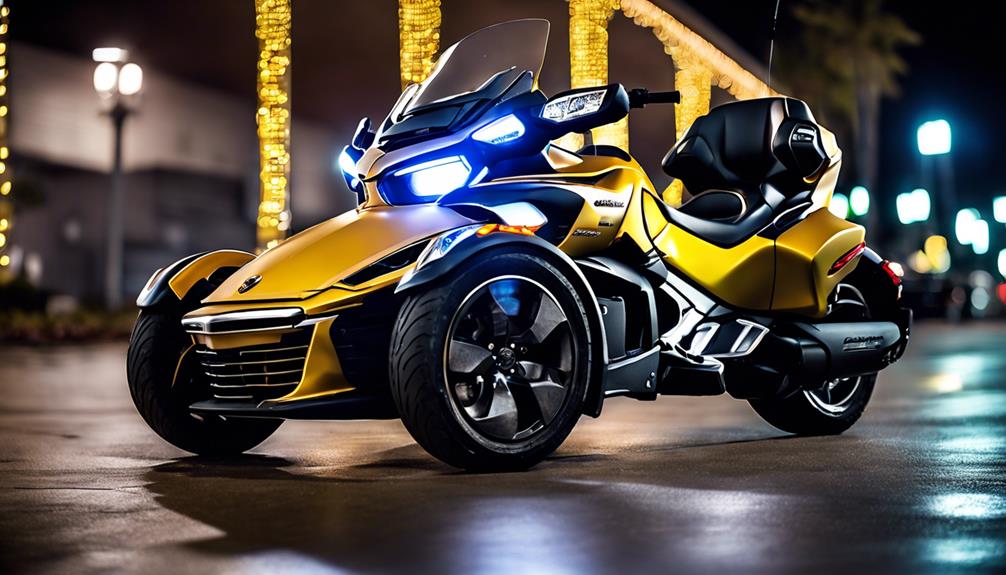
What distinguishes the various LED types used in Can-Am Spyder lighting systems? LED lights for Can-Am Spyder vehicles come in different types, each offering unique features to enhance the lighting experience. SMD LEDs, which stand for Surface Mount Device LEDs, are commonly used for their high brightness and energy efficiency. They provide a powerful lighting solution while consuming less power compared to traditional lighting options. Another popular choice is RGB LEDs, which offer customizable color options and dynamic lighting effects, allowing riders to personalize their lighting setup. Additionally, COB LEDs, or Chip on Board LEDs, provide a higher density of light output in a compact design, making them suitable for applications where space is limited.
| LED Type | Features |
|---|---|
| SMD LEDs | High brightness, energy-efficient |
| RGB LEDs | Customizable colors, dynamic effects |
| COB LEDs | High light output density, compact design |
Installation Process Step-by-Step

When installing LED lighting on a Can-Am Spyder, it's essential to pay attention to the tools needed and follow precise wiring instructions for a successful setup.
Ensuring a secure bond by using adhesion promoter and cleaning mounting areas thoroughly with alcohol prep pads is vital.
Connecting wire groups with add-on harnesses and testing brake light signals before completion are key steps in the installation process.
Tools Needed
For a seamless installation process of LED lights on the Can-Am Spyder, gather the essential tools such as a T15 Torx wrench, Phillips head screwdriver, and zip ties for securing wires.
The T15 Torx wrench is vital for removing and installing various parts of the Can-Am Spyder to access the areas where the LED lights will be placed. The Phillips head screwdriver is handy for loosening and tightening screws during the installation process.
Additionally, having zip ties on hand helps in organizing and securing wires neatly to prevent any tangling or interference with other components. Using these tools guarantees a smooth and efficient installation, minimizing the risk of damage to the LED lights and creating a professional-looking outcome.
Wiring Instructions
To seamlessly integrate LED light strips onto your Can-Am Spyder, utilize designated harnesses for connecting them to the control box.
Secure the wire connections with zip ties to prevent any loose connections while in operation.
Test the brake light signal using a test light to guarantee proper functionality post-installation.
Make use of the factory wiring for a plug-and-play installation process to simplify the wiring steps.
By following the provided step-by-step instructions, you can confirm a successful and functional LED lighting system on your Can-Am Spyder.
Remember to adhere to the instructions carefully to guarantee a seamless integration of the new LED lights and take full advantage of any Bluetooth-enabled features that come with the lighting system.
Factors to Consider Before Buying
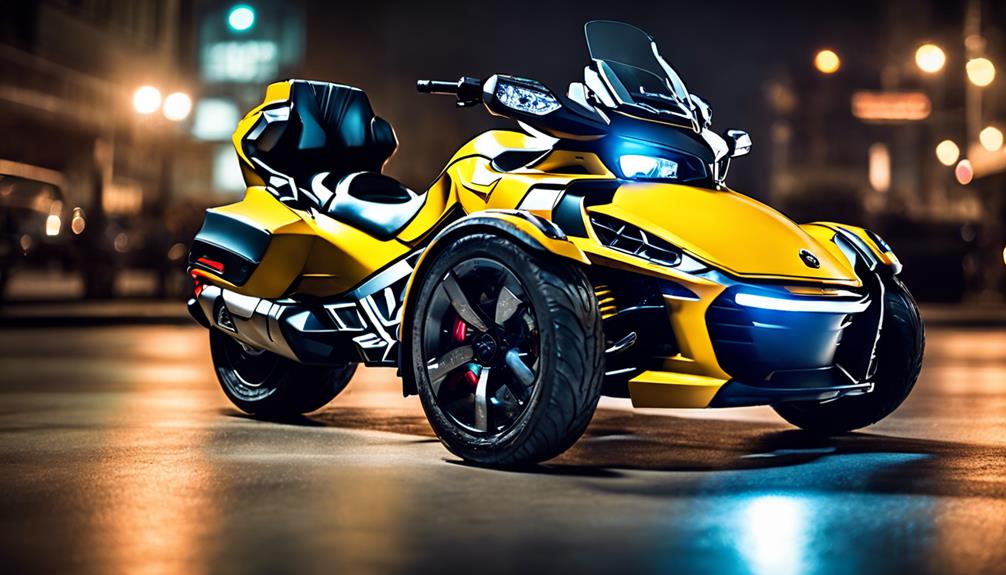
Before purchasing LED lights for your Can-Am Spyder, it's essential to carefully consider various factors to guarantee you make the best choice for your needs.
Make sure to assess the type of LED lights required, whether it be accent lighting, headlights, or brake lights, to suit your specific preferences and riding requirements. Evaluate the brightness levels and color options available to ensure excellent visibility on the road while also reflecting your personal style.
Additionally, check compatibility with your Can-Am Spyder model to avoid any installation issues, ensuring a seamless plug-and-play experience. When selecting LED lights, aim for waterproof and durable options that can withstand diverse weather conditions and road vibrations for long-lasting performance.
Compare features like Bluetooth control, app compatibility, and customization options to enhance your overall riding experience. Lastly, consider the minimum power requirements to guarantee the LED lights meet the electrical needs of your Can-Am Spyder efficiently.
Maintenance Tips for Longevity
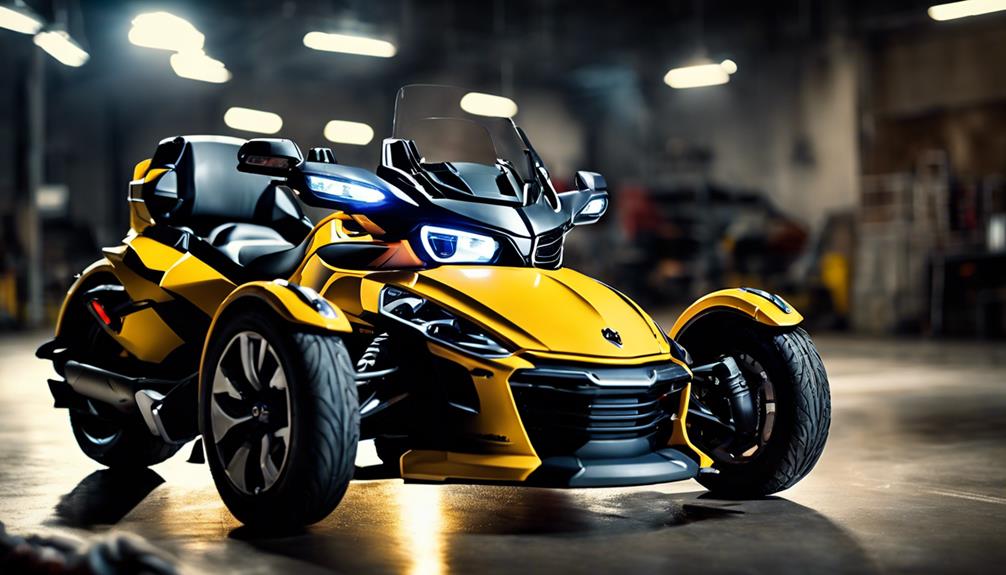
Evaluating the upkeep needs of your Can-Am Spyder's LED lights is important for ensuring their longevity and peak performance. Regularly cleaning the LED lights with a mild soap solution and soft cloth helps prevent dirt buildup and maintains brightness.
It's essential to check the wiring connections periodically to make sure they're secure and free from any corrosion or damage. Additionally, inspecting the control box and app functionality for any software updates or maintenance requirements is recommended.
To prolong the lifespan of your LED lights, avoid exposing them to harsh chemicals or extreme temperatures. If you encounter any issues, refer to the user manual for troubleshooting steps or contact customer support for assistance.
How LED Lighting Improves Safety
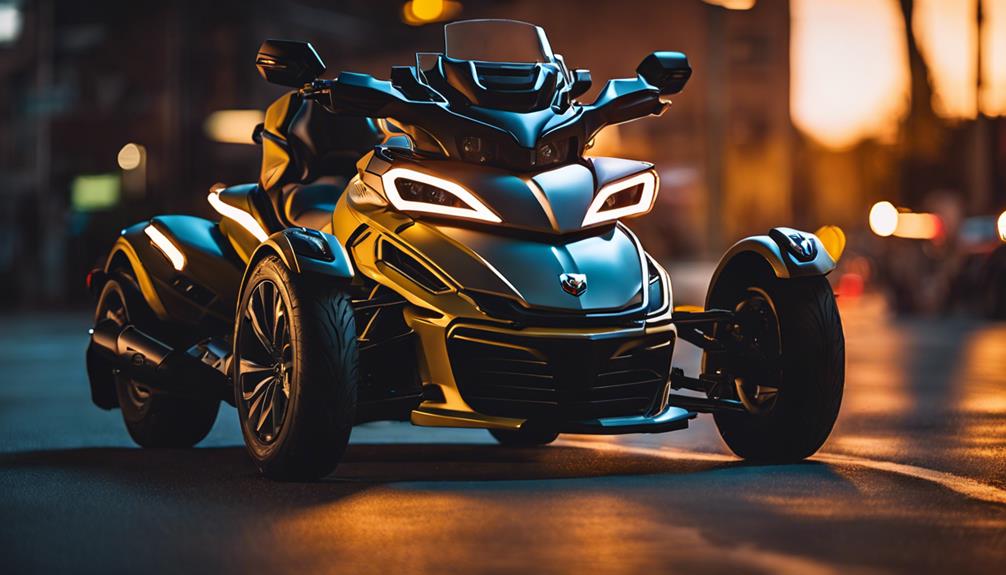
Enhancing safety on the road, LED lighting on a Can-Am Spyder greatly improves visibility for the rider and surrounding motorists. The brightness of LED lights not only makes the rider more noticeable to other road users but also illuminates the surroundings, enhancing road visibility during night rides.
LED lights have a longer lifespan than traditional bulbs, reducing the need for frequent replacements and maintenance. Additionally, these lights are energy-efficient, drawing less power from the vehicle's battery while still providing bright and clear illumination.
Customization Options Available
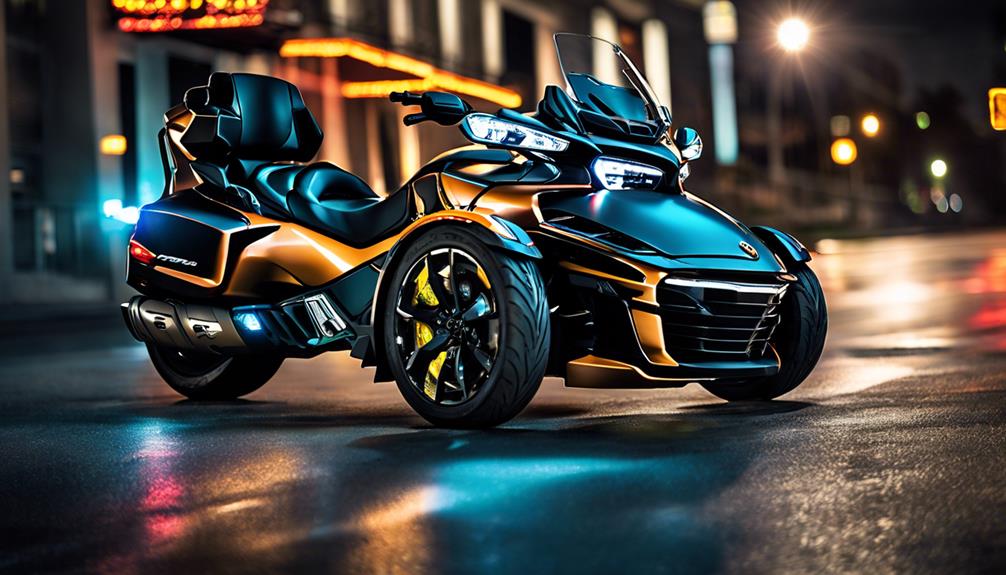
LEDGlow offers a range of customization options for Can-Am Spyder LED lights, allowing riders to personalize their lighting experience. Riders can choose from various color options such as red, blue, green, white, and orange to suit their style preferences. Additionally, customization options include different lighting patterns like strobing, fading, flashing, and solid illumination, providing versatility for different moods and occasions.
For a more dynamic experience, the LED lights can be synced with music, creating a visually stimulating ride. Users can further enhance their customization by adjusting the brightness and speed of the LED lights through the Bluetooth control app, giving them full control over their lighting display.
LEDGlow also offers firmware updates to ensure that riders have access to additional customization features and improvements, keeping their Can-Am Spyder LED lights up to date with the latest advancements in LED technology.
Comparing LED Vs. Traditional Lighting
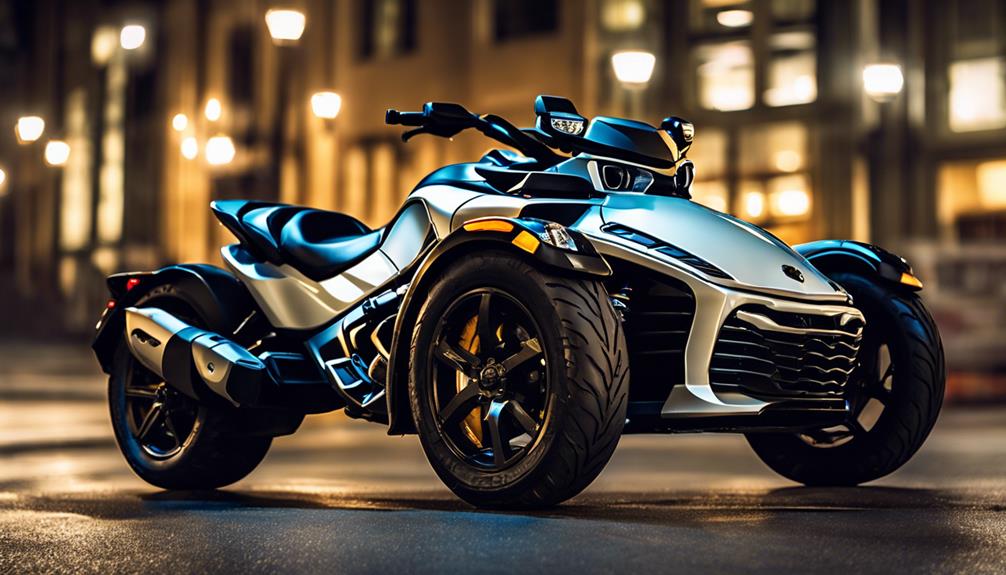
LED lights surpass traditional lighting options when it comes to efficiency, lasting notably longer and requiring less energy consumption.
Their brightness is unparalleled, offering improved visibility for riders, especially in low-light conditions.
Contrasting LED to traditional lighting exposes distinct advantages in performance and durability.
Efficiency of LED
LED lighting excels in efficiency compared to traditional lighting, consuming up to 80% less power while offering longer durability and enhanced brightness. This efficiency stems from the way LEDs convert electricity into light, wasting minimal energy as heat.
The reduced power consumption not only translates to lower energy bills but also contributes to a more sustainable environment. With their longer lifespan, LED lights require fewer replacements, reducing maintenance costs.
Additionally, the enhanced brightness and focused illumination of LEDs improve visibility on the road, enhancing safety for riders. Due to their energy efficiency, durability, and brightness, LEDs have become the preferred choice for modern lighting solutions, offering a balance of performance and sustainability that traditional lighting struggles to match.
Longevity of LEDs
Comparing the longevity of LEDs to traditional lighting sources reveals a significant difference in lifespan and efficiency. LEDs typically last around 50,000 hours, a stark comparison to incandescent bulbs that usually burn out after 1,000 to 2,000 hours.
This extended lifespan not only reduces the frequency of replacements but also translates to long-term cost savings for consumers. Additionally, LED lights are up to 80% more energy-efficient than traditional options, leading to reduced power consumption and lower electricity bills.
The minimal heat emission from LEDs compared to incandescent bulbs not only enhances safety but also contributes to their durability. With faster response times and resistance to vibrations, LEDs prove to be a reliable and long-lasting lighting solution, especially in demanding environments like off-road settings.
Brightness Comparison
In addition, modern LED lighting outshines traditional incandescent options with superior efficiency and illumination intensity. LED lights are up to 80% more efficient than traditional incandescent lights, providing brighter illumination with less power consumption.
Additionally, LEDs have a longer lifespan of up to 25,000 hours compared to traditional bulbs, reducing the frequency of replacements and maintenance. LED lights emit a focused and directional light beam, enhancing visibility on the road for the rider and increasing safety.
Unlike traditional lighting systems that generate more heat during operation, LEDs remain cool to the touch, reducing the risk of accidental burns or damage. Moreover, LED lights offer a wider range of color options and customization features, allowing riders to personalize their Can-Am Spyder with unique lighting effects.
Troubleshooting Common Issues
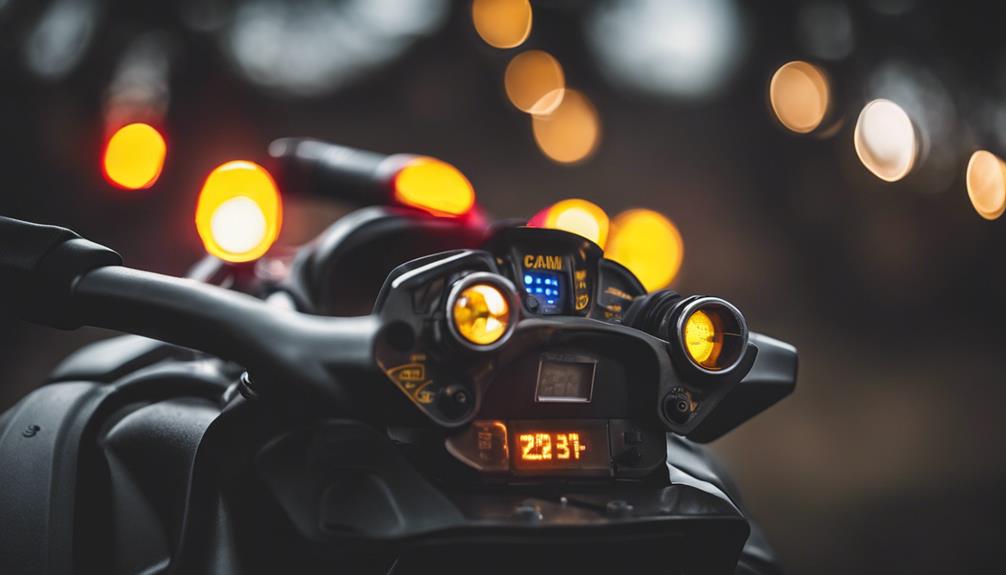
To effectively troubleshoot common issues with your Can-Am Spyder LED lighting system, start by verifying the power source and connections. Confirm that the LED lights are receiving power by checking the connections and the power source.
Next, ensure that the Bluetooth control box is correctly paired with the device for remote operation. If the lights are still not functioning properly, examine the wiring harness for any signs of damage or loose connections that could be causing issues.
Additionally, address any software or app-related issues by reinstalling the LEDGlow Motorcycle Control App. If these steps don't resolve the problem, it's advisable to contact LEDGlow customer support for further assistance.
Enhancing Aesthetics With LED Lighting

Enhancing the aesthetics of your Can-Am Spyder with LED lighting offers colorful options and customization possibilities.
LED lights can be tailored to match your personal style, adding a modern and stylish touch to your ride.
Colorful LED Options
Exploring the colorful LED options for your Can-Am Spyder can instantly elevate its aesthetics with vibrant lighting choices. LED lights can be customized to display a wide range of colors, including red, blue, green, purple, and white, adding a personalized touch to your ride.
These colorful LED options come with various lighting modes like strobe, fade, and flash, allowing you to create dynamic lighting effects that stand out on the road. Not only do LED lights enhance the visual appeal of your Spyder, but they're also energy-efficient and long-lasting, making them a cost-effective choice.
Installing LED strips in different locations on your Spyder, such as under the frame rail or around the headlights, can create an eye-catching look that's sure to turn heads.
Customization Possibilities
With LED lighting, riders can effortlessly enhance the aesthetics of their Can-Am Spyder by infusing personalized style and vibrant illumination options. LED technology offers customizable color choices to match the unique look of your Spyder, allowing for a personalized touch.
By incorporating various lighting effects like strobing, fading, and flashing patterns, you can create a visually striking appearance that sets your Spyder apart. Strategically placing LED strips to highlight specific features of your vehicle adds a touch of personalization, while integrating LED lighting in different areas such as the front nose, frame rail, and air intake scoops can give your Spyder a dynamic and eye-catching look.
Not only does LED lighting enhance the visual appeal, but it also improves visibility on the road, enhancing safety during night rides or in low light conditions.
Frequently Asked Questions
How to Setup LED Lights?
To set up LED lights on a Can-Am Spyder, follow these steps:
- Connect the light strips to the control box using the provided harnesses and connectors.
- Mount the strips in recommended spots for best results.
- Verify the lights to guarantee proper connection before finalizing the installation.
- Use adhesion promoter and zip ties for secure mounting.
- Follow specific mounting instructions for areas like the swing arm, frame rail, and headlight surround to achieve desired lighting effects.
How to Turn on Temu Led Lights?
To turn on Temu LED lights, make sure the control box LED status flashes yellow.
Use the LEDGlow Motorcycle Control App to pair your device with the control box.
Press the power button on the app to activate the LED lights.
When not in use, disconnect your device from the control box to save power.
Troubleshoot any connection issues by following the provided instructions.
How to Get LED Lights to Stick?
To get LED lights to stick securely, use adhesion promoter for a strong bond. Clean mounting areas with alcohol prep pads before applying the promoter for better adhesion.
Press the LED strips firmly onto desired locations for a secure hold. Secure strips with zip ties for added stability whenever possible.
Consider different mounting locations for best effect and longevity. Remember, a strong foundation guarantees lights stay put for the long haul.
Can Am Spyder Top Speed?
The Can-Am Spyder's top speed varies by model, with the F3 hitting up to 130 mph and the RS, RT, and ST models reaching around 110-120 mph. Factors like engine power, aerodynamics, and weight influence the top speed.
Riders appreciate the Spyder's stability and handling at high speeds for a thrilling yet safe ride. Adhering to speed limits and safety rules is essential for a secure and enjoyable riding experience.
Conclusion
To sum up, Can-Am Spyder LED lighting offers a plethora of benefits, from increased visibility to enhanced aesthetics. By understanding the different LED types, following the installation process step-by-step, and considering maintenance tips, riders can enjoy long-lasting and customizable lighting options.
Comparing LED vs. traditional lighting can help make an informed decision, while troubleshooting common issues guarantees top performance. With a focus on enhancing aesthetics, Can-Am Spyder LED lighting is a practical and stylish choice for riders.
Lighting
How Much Energy Can You Save With LED Lighting?
Harness the power of LED lighting to slash energy costs by up to 90% – find out how to unlock these savings!
LED lighting has the potential for significant energy savings, with LEDs consuming at least 75% less energy than incandescent bulbs. They can save up to 90% energy, resulting in substantial cost reductions. LED lights last up to 25 times longer than traditional bulbs, minimizing maintenance costs. By 2035, widespread adoption of LED technology is expected in the US, highlighting the efficiency of these lighting solutions. Switching to LED bulbs can result in savings of around $4,000 over a 20-year lifespan. Learn more about how LED lighting can improve energy efficiency and lower costs.
Key Takeaways
- LED lighting can save up to 90% energy compared to traditional options.
- LEDs consume 6-7 watts, reducing monthly lighting costs significantly.
- Switching to LEDs can save homeowners around $4,000 over a 20-year lifespan.
- Widespread LED adoption could save 569 TWh annually by 2035.
- LED bulbs last up to 25 times longer, reducing maintenance costs.
LED Lighting Energy Efficiency
LED lighting significantly reduces energy consumption compared to traditional incandescent lighting, offering substantial cost savings and environmental benefits. With LEDs using at least 75% less energy than incandescent bulbs, their efficiency is undeniable.
Not only do LEDs help in cutting electricity costs, but they also last up to 25 times longer, reducing the frequency of replacements. This extended lifespan translates to reduced maintenance and replacement expenses over time.
By 2035, the adoption of LED technology is expected to be widespread in the US, with the majority of lighting installations utilizing this energy-efficient option. The energy savings potential is significant, with estimates suggesting that by 2035, LED lighting could save up to 569 terawatt-hours annually.
Residential users alone can benefit from substantial savings, with an average of $225 per year in energy costs saved by switching to LEDs from traditional bulbs. The shift to LED lighting not only makes financial sense but also contributes to a more sustainable and environmentally friendly lighting solution.
Comparing LED Vs. Incandescent Costs
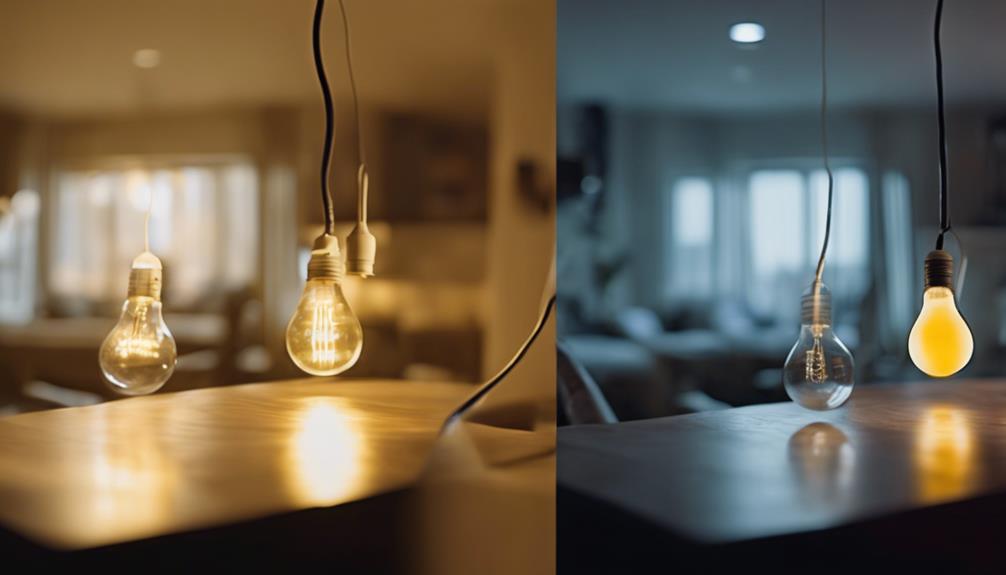
With the potential for substantial long-term savings evident, comparing the costs of using LED lighting versus incandescent bulbs proves to be a financially wise decision for homeowners. When considering LED lighting versus incandescent bulbs, the following points should be taken into account:
- LED lighting can save homeowners around $4,000 over a 20-year LED lifespan compared to incandescent bulbs.
- The average home with incandescent bulbs uses about 2,000 kWh of electricity per year, costing $215 annually at $0.10 per kWh.
- Switching to LEDs for lighting can result in significant cost savings over time due to their longevity and energy efficiency.
LED bulbs not only last longer but also consume substantially less electricity per month, leading to lower costs compared to incandescent lighting options. By making the switch to LED lighting, homeowners can enjoy both the energy savings and cost savings that come with this more efficient lighting choice.
Monthly Savings With LED Bulbs

By switching to LED bulbs, homeowners can greatly reduce their monthly lighting costs compared to traditional incandescent or CFL bulbs. LED lights are highly energy-efficient, consuming only 6-7 watts and saving 1.56 kWh per month, a significant improvement over CFL bulbs that consume 2.4 kWh.
The monthly cost for LED lights varies depending on lumens output, with 400-500 lumens costing around $0.25, 650-850 lumens at $0.33, and 1000-1400 lumens at $0.49. This cost discrepancy is due to the lower wattage consumption of LED lights, which ultimately leads to substantial monthly savings.
Homeowners looking to cut down on their electricity bills should consider making the switch to LED bulbs, as they not only provide brighter illumination but also offer cost-efficient lighting solutions. Making the choice to switch to LED can result in noticeable reductions in monthly lighting expenses, making it a smart investment for long-term cost savings.
Calculating LED Energy Consumption
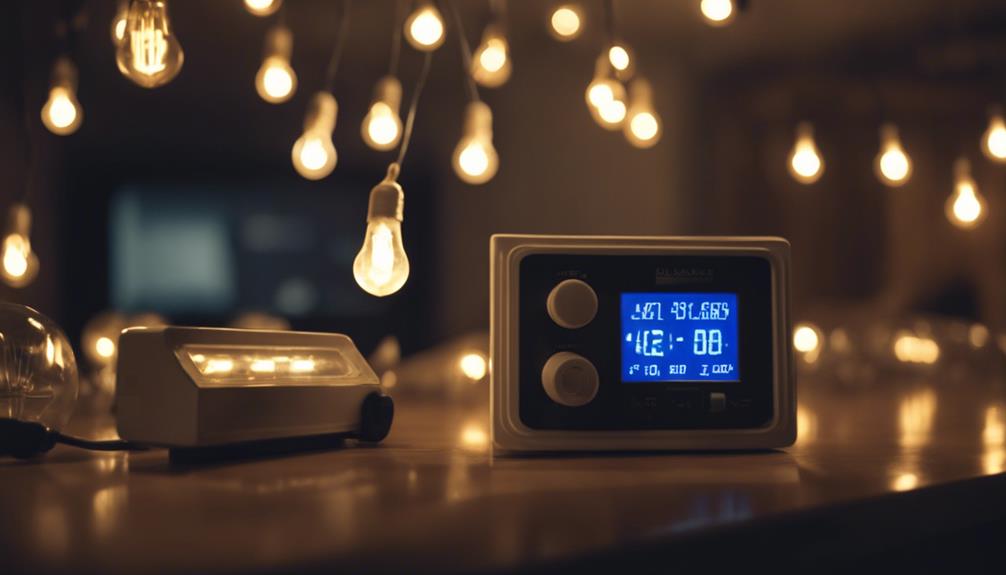
To calculate the energy consumption of LED lighting, one must take into account factors such as watts, lumens, and the average cost of electricity in the US.
When determining the efficiency of LED light bulbs, it's important to consider the power consumption and brightness they offer compared to traditional lighting options.
Here are some key points to keep in mind:
- LED lights typically consume between 6 to 28 watts, providing a wide range of energy-saving choices.
- The power consumption of LEDs can save up to 80% when compared to traditional lighting options.
- Understanding the relationship between lumens, watts, and the cost of electricity in cents per kilowatt-hour is vital for accurately calculating LED energy consumption.
Maximizing Energy Efficiency With LEDS

Maximizing energy efficiency with LEDs involves optimizing their long-lasting performance and significant energy-saving capabilities. LED lighting surpasses traditional incandescent bulbs by offering up to 90% energy savings. Additionally, LED bulbs lasting up to 25 times longer contribute to enhanced efficiency. The United States is moving towards widespread LED technology adoption, with estimates suggesting that a majority of lighting installations will be LED-based by 2035. This shift could result in substantial energy savings, potentially reaching 569 terawatt-hours annually by 2035. Concerning energy use, residential LEDs are exceptionally efficient, consuming at least 75% less energy than incandescent lighting. This shift not only benefits the environment but also leads to significant cost savings for consumers. Utilizing LED lighting not only reduces energy consumption but also emphasizes the importance of efficiency in lighting solutions.
| Aspect | LED Lighting | Incandescent Bulbs |
|---|---|---|
| Energy Savings | Up to 90% | – |
| Lifespan | Up to 25 times longer | – |
| Energy Use | 75% less than incandescent bulbs | – |
LED Lighting Cost Analysis
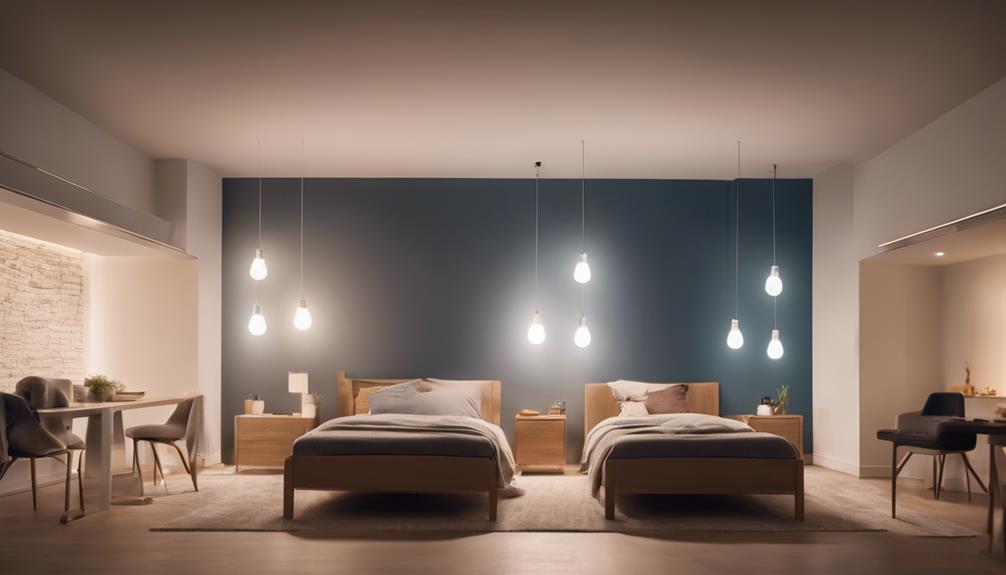
LED lighting cost analysis is essential for understanding the financial benefits of switching to LED bulbs. By comparing the cost per bulb and potential energy bill savings, consumers can make informed decisions about their lighting choices.
Evaluating the long-term savings potential of LED lights can help individuals and businesses optimize their energy efficiency and reduce electricity expenses.
Cost per Bulb
The price range for LED bulbs, varying from $2 to $20 based on type and brand, plays a crucial role in determining the overall cost-effectiveness of switching to LED lighting. When contemplating the cost per bulb, it's essential to factor in the long-term savings and benefits associated with LED bulbs.
Here are some key points to ponder:
- LED bulbs are energy-efficient, consuming up to 90% less energy than incandescent bulbs.
- LED bulbs can last up to 25,000 hours, greatly reducing replacement costs.
- The initial investment in LED bulbs is quickly offset by long-term energy savings.
Considering these factors can help individuals make informed decisions about the cost-effectiveness of adopting LED lighting.
Energy Bill Savings
Switching to LED lighting can lead to substantial energy bill savings due to their markedly lower energy consumption compared to traditional incandescent bulbs. LED bulbs use up to 90% less energy, resulting in an average annual savings of about $225 in energy costs for an average household.
Over a 20-year period, shifting to LEDs can amount to approximately $4,000 in energy savings. LED lights only consume 6-7 watts, leading to reduced electricity bills. With an average monthly cost of $0.25 to $0.49 to operate, LED lights are a cost-effective choice for saving money on energy expenses.
Making the switch to LED bulbs can significantly decrease energy costs per year, making them a favorable option for those looking to save on their electricity bills.
Environmental Impact of LED Usage

With its significant energy efficiency, LED lighting presents a promising solution for reducing environmental impact in the field of lighting technology. LED lighting can reduce energy consumption by at least 75% compared to incandescent lighting, leading to substantial energy savings and lower carbon emissions.
By 2035, it's estimated that the majority of lighting installations in the US will utilize LED technology, showcasing a shift towards sustainability and a greener environment. LEDs last up to 25 times longer than incandescent lighting, further reducing environmental impact through decreased waste and resource usage.
The energy savings potential from widespread LED adoption could reach 569 TWh annually by 2035, demonstrating the significant positive impact that LED lighting can have on promoting sustainability and reducing carbon footprints.
Tips for Efficient LED Lighting
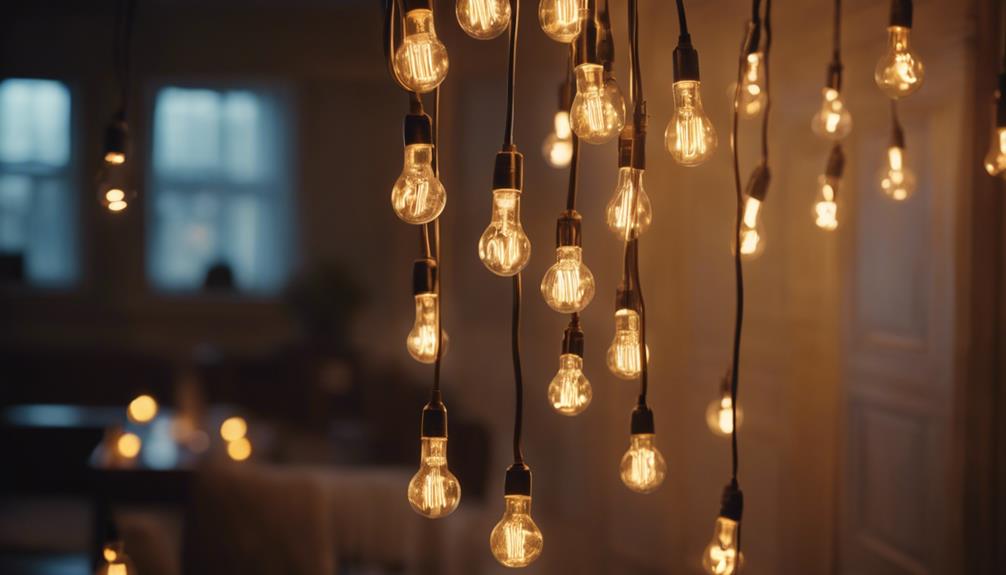
Energy-saving LED fixtures and proper lighting placement are essential for maximizing energy efficiency with LED lighting.
By strategically positioning fixtures and using the right bulbs for each area, households can greatly reduce energy consumption.
These simple tips can lead to substantial savings on electricity bills while enjoying the benefits of long-lasting LED lighting.
Energy-Saving LED Fixtures
For maximum energy efficiency and cost savings, consider incorporating energy-saving LED fixtures into your lighting setup. LED fixtures are a great choice for saving energy and money due to their high efficiency and long lifespan. Here are some tips to make the most of energy-saving LED fixtures:
- Opt for LED fixtures with ENERGY STAR certification for the greatest energy savings.
- Choose dimmable LED fixtures to adjust light levels and reduce electricity consumption.
- Install automatic timers with LED fixtures to turn off lights when not in use, maximizing energy efficiency.
Proper Lighting Placement
Strategically placing LED lights can greatly enhance energy efficiency and lighting effectiveness in any setting. By optimizing the placement of LED fixtures, energy consumption can be reduced while ensuring that illumination levels are maximized where needed. Utilizing task lighting with LEDs in specific work areas not only improves productivity but also saves energy by focusing light where it's most beneficial. Well-placed LED fixtures create a comfortable and energy-efficient lighting environment in homes and businesses. To better understand the impact of proper lighting placement, consider the following table:
| Lighting Placement Tips | Benefits |
|---|---|
| Directing light where needed most | Reduces energy consumption |
| Optimizing illumination levels | Minimizes wasted energy |
| Focusing on task lighting in work areas | Improves productivity and saves energy |
Frequently Asked Questions
How Much Money Can LED Lights Save You?
Switching to LED lights can save individuals a significant amount of money. LED lights can save around $225 per year in energy costs for an average household. Over a 20-year LED lifespan, this translates to approximately $4,000 in savings.
These lights consume 6-7 watts, resulting in minimal monthly costs for various lumens. LED lights offer substantial monthly savings compared to other types of bulbs, making them a cost-effective choice for households.
How Much Electricity Does an LED Save?
LED lighting saves a significant amount of electricity compared to traditional incandescent bulbs. LEDs consume 6-7 watts, much less than CFLs and incandescents. This results in a substantial reduction in energy usage.
Switching to LEDs can lead to substantial energy savings over time, making them a cost-effective and eco-friendly lighting option for households and businesses alike.
How Much Does It Cost to Run a LED Light for 24 Hours?
Running a 7W LED light bulb for 24 hours costs about $0.027 in electricity. LED lights are known for their energy efficiency, consuming up to 80% less power than traditional options.
The cost of operating LED lights for a full day is significantly lower compared to other bulb types. LED bulbs typically consume between 6 to 28 watts, offering versatility for various lighting needs.
Switching to LED lighting can result in significant long-term savings on electricity bills.
Are LED Lights 100% Efficient?
LED lights aren't 100% efficient, typically converting around 80-90% of electricity into light. The remaining 10-20% is usually turned into heat, making LEDs more efficient than incandescent bulbs. Efficiency can vary based on LED quality and design, with some high-quality LEDs achieving closer to 90% efficiency.
Heat sinks are commonly used in LED designs to manage excess heat generated during operation. Despite not being perfect, LED lighting is considerably more energy-efficient than traditional options.
Conclusion
To sum up, switching to LED lighting can save you a ton of energy and money in the long run. The cost savings are significant, and the environmental benefits are substantial.
By making the switch to LED bulbs, you can illuminate your space while also reducing your electricity bill and carbon footprint. It's a win-win situation that everyone should consider for a brighter, more efficient future.
Lighting
LED Strip Lighting Cost Explained: How Much Does It Cost?
Intrigued by the cost of LED strip lighting? Unravel the pricing factors and discover how much you can save in the long run.
LED strip lighting costs are determined by various components such as LED lights, aluminum profiles, connectors, and accessories. Prices for systems can start at $35.00 per foot, with individual strips typically ranging from $20.00 to over $50.00. Aluminum profiles can vary in price from $7.00 to $20.00 per foot, providing durability and customization options. Quality, quantity, and customization are all factors that can influence the overall cost of LED strip lighting. Additional accessories like end caps and connectors can also impact the total cost. LED strips are known for their energy efficiency compared to traditional lighting, which can result in long-term savings. It is important to understand these cost variations in order to effectively plan your budget and get the most out of your LED strip lighting. More insights are available for those interested.
Key Takeaways
- LED strip lighting costs start at $35.00 per foot for complete systems.
- Separate LED strips range from $20.00 to over $50.00 each.
- Additional accessories like end caps, connectors, and clips add to the total cost.
- Aluminum profiles range from $7.00 to over $20.00 per foot, impacting expenses.
- Customized options and bulk purchases may influence overall LED strip lighting costs.
LED Strip Lighting Materials Cost
Exploring the materials cost of LED strip lighting reveals the key components that contribute to the overall expense of lighted stair nosings. LED strip lights are the primary cost driver, with complete systems starting at $35.00 per foot. The separate LED strip costs range from $20.00 to over $50.00 each, depending on factors like energy consumption, power supply, and cost savings.
These strips are essential for providing illumination in both residential and commercial settings. Additionally, LED lighting connectors play a significant role in the overall cost, typically priced around $20.00 each.
The choice between aluminum and PVC stair nosing profiles also impacts the total expense, with aluminum profiles being anodized for customization and PVC profiles being clear for lighting visibility. While aluminum profiles are generally more expensive due to their material and customization options, both types offer a durable and stylish solution for lighted stair nosings.
General Cost of Aluminum Profiles
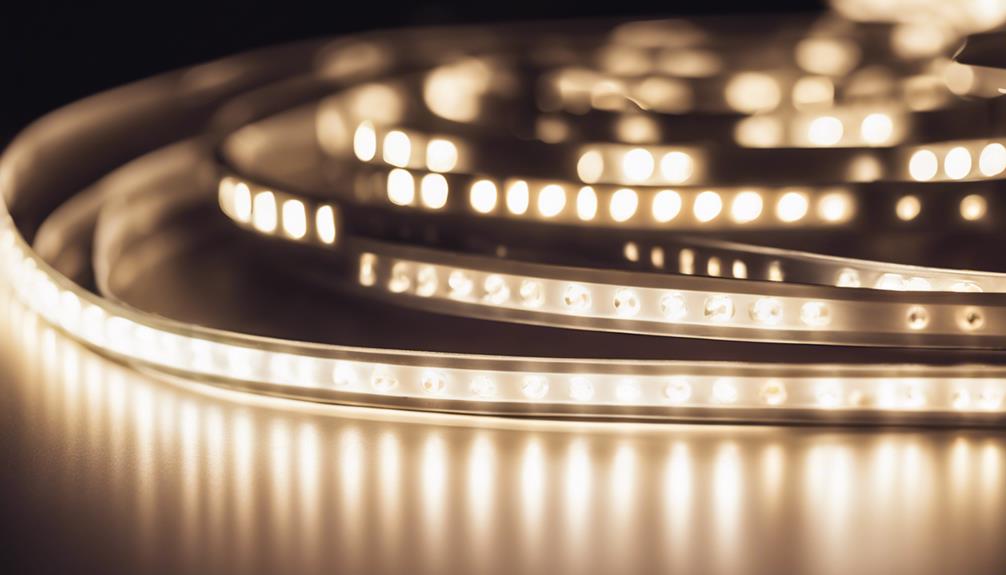
The cost of aluminum profiles for LED strip lighting installations typically ranges from $7.00 to over $20.00 per foot. These profiles play an important role in the installation process, providing both functional support and aesthetic appeal to the lighting setup. Aluminum profiles are often used for LED stair lighting applications due to their durability and strength, making them ideal for high-traffic areas. Additionally, these profiles can be customized with anodized color options to match various decors, although this customization may come with additional costs.
To provide a clearer overview, here is a breakdown of the general cost of aluminum profiles for LED strip lighting installations:
| Features | Description | Cost Range |
|---|---|---|
| Material | Aluminum | $7.00 – $20.00 |
| Per Foot | Length of aluminum profile per foot | $7.00 – $20.00 |
| Anodized Color Options | Additional cost for custom color finishes | Variable |
Aluminum profiles not only enhance the visual appeal of LED strip lights but also contribute to the overall functionality and longevity of the lighting system.
LED Strip Lighting Cost Variations
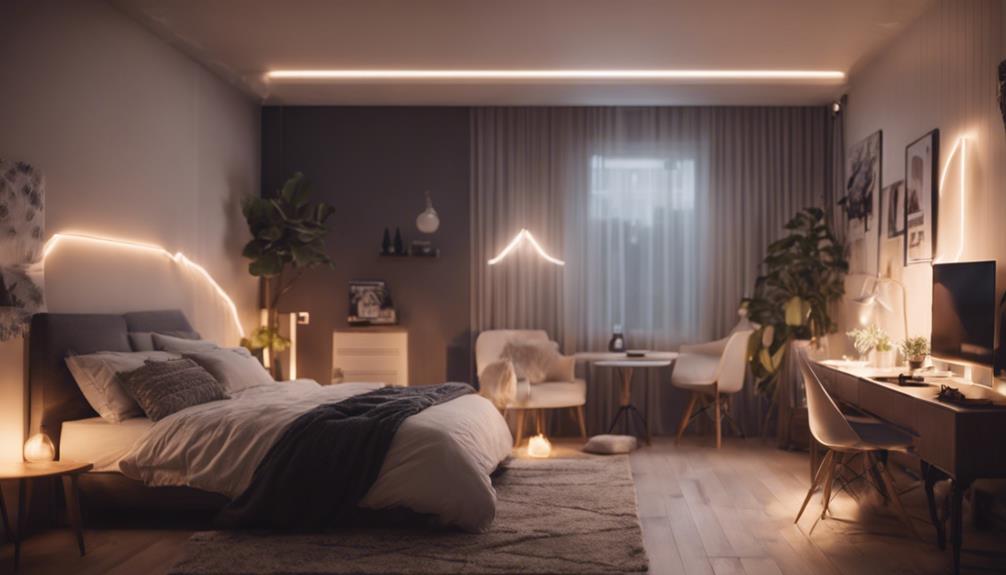
Costs for LED strip lighting can vary greatly depending on factors such as length, quantity, and color variations of the LED strips. When considering the cost of LED lights, there are several key aspects to keep in mind:
- Specifications: The specific features and quality of LED strips can affect their individual prices.
- Quantity: Buying LED strips in bulk may offer cost savings compared to purchasing individual units.
- Customization Options: Opting for customized LED strip lighting solutions may come at a higher cost.
- Budgeting: Understanding the cost breakdown of LED strip lighting components is vital for effective budget planning.
These factors, along with the need for additional accessories like aluminum profiles and installation components, contribute to the overall cost variation in LED strip lighting projects. By carefully evaluating these elements, individuals can make informed decisions when planning and executing LED strip lighting installations.
Additional Accessories Cost Analysis
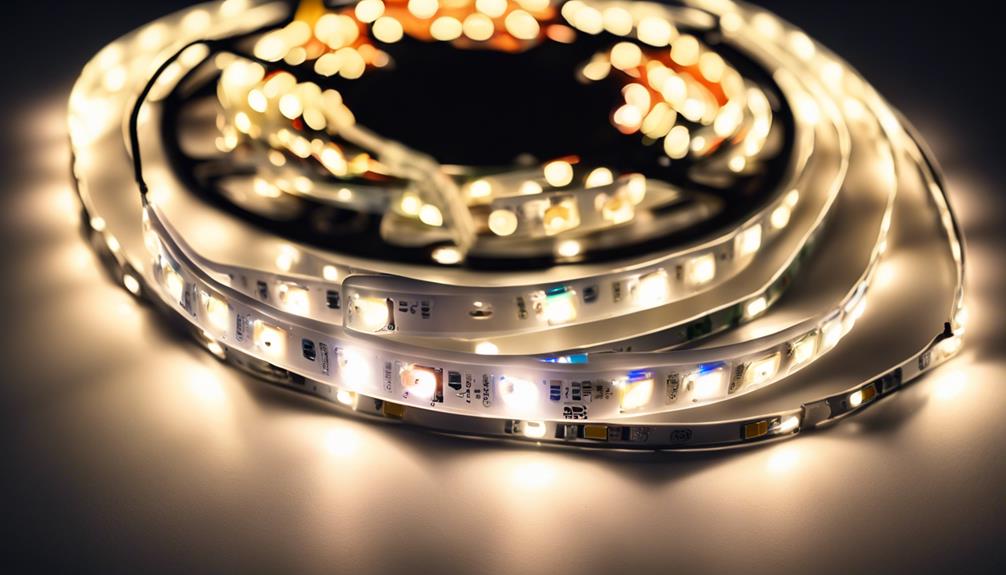
How much do essential accessories like end caps and carrier tubes contribute to the overall cost of LED strip lighting installations?
End caps for LED strip lighting typically cost less than $5 each, while carrier tubes and clips, important for installation, can be around $2 per foot each. Special connectors, which may be needed, could cost approximately $20 each, depending on the quantity required. It's worth considering using existing wiring instead of specialized connectors to save on additional costs.
Understanding the cost of accessories such as end caps, carrier tubes, and clips is important for accurate budgeting when setting up LED strip lighting. These additional expenses, although relatively small compared to the initial cost of LED lights, can add up, impacting the overall cost of the project.
Considering these costs alongside the potential energy savings and long-term benefits of LED lighting is essential for making an informed decision.
Cost Comparison: LED Strips Vs. Aluminum Profiles
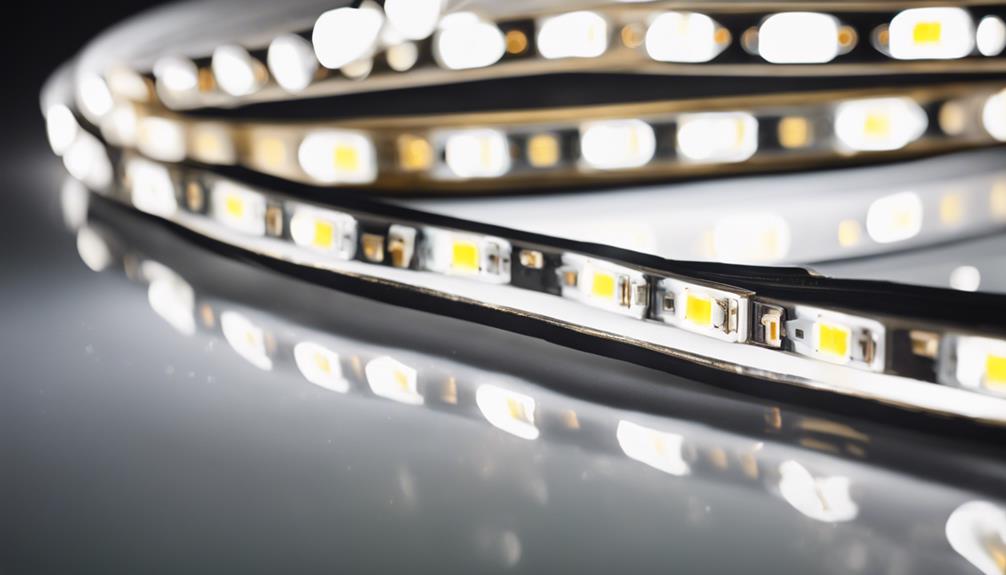
Comparing the expenses for LED strips and aluminum profiles, which option proves to be more cost-effective for lighting installations? When evaluating the Cost Per LED Linear Light for residential and commercial spaces, it's important to take into account the long-term savings associated with energy consumption. Here are some key points to keep in mind:
- LED strips offer lower energy consumption compared to traditional fluorescent bulbs, leading to significant energy savings over time.
- Aluminum profile stair lights typically come at a higher initial cost per foot compared to LED strips, but the energy-efficient LED technology can result in substantial savings in the long run.
- PVC stair lights are priced similarly to aluminum profiles, but the energy efficiency of LED lighting makes them a more cost-effective choice in the long term.
- Making the switch to LED lighting, whether through LED strips or aluminum profiles, can result in lower energy consumption and greater energy savings, making it a financially wise choice for both residential and commercial lighting installations.
Frequently Asked Questions
How Much Does It Cost to Run LED Light Strips?
LED light strips are cost-effective to run, with monthly costs varying based on lumens. For lower brightness levels of 400-500 lumens, the cost is around $0.25.
Moving up to 650-850 lumens increases it to approximately $0.33 per month. Higher brightness ranges of 1000-1400 lumens come in at about $0.49 monthly.
Switching to LED light strips can lead to significant savings due to their energy efficiency compared to traditional lighting options.
What Is the Cost of LED Strip?
LED strip lighting costs vary based on factors like length, quantity, and color. Prices can range from $20 to over $50 per strip for stair lighting.
Complete LED aluminum profile stair light systems start at around $35 per foot. The cost is influenced by the brand, quality, and features of the LED strip.
Generally, expect to pay more for longer strips, higher quantities, and premium features.
Do LED Lights Run up the Electric Bill?
LED lights don't markedly run up the electric bill due to their low power consumption. They consume 6-7 watts, resulting in a cost of $0.25 per month for 400-500 lumens.
This is more cost-effective compared to CFL bulbs using 8-12 watts at $0.33 per month. LED lights are energy-efficient, leading to noteworthy monthly cost savings and reduced energy consumption when used as a lighting option.
How Much Do LEDS Cost?
LED lighting cost can vary based on factors such as length, color options, and quantity. Prices start around $35 per foot for complete systems.
If buying LED strips separately, costs can range from $20 to over $50 per strip.
LED aluminum profile stair lights often bundle both the profile and the LED strip. Customization options allow for selecting components like aluminum profiles and LED strips individually.
Conclusion
To sum up, when considering the cost of LED strip lighting, it's important to factor in the materials, additional accessories, and the variations in prices. While aluminum profiles may add to the overall cost, they provide durability and a sleek finish.
Ultimately, choosing between LED strips and aluminum profiles comes down to personal preference and budget. As the saying goes, 'you get what you pay for,' investing in quality materials can enhance the longevity and effectiveness of your lighting setup.
Lighting
How Much Energy Does LED Lighting Save?
Opt for LED lighting to achieve substantial energy savings and unlock a world of benefits waiting to be explored!
LED lighting is an energy-efficient option that can help save a significant amount of energy, using about 75% less energy than traditional incandescent bulbs. This considerable energy efficiency leads to noticeable cost savings and environmental benefits. Switching to LED bulbs, which typically only use 10 watts compared to the 60 watts of incandescent bulbs, can result in significant reductions in electricity expenses. In general, the long lifespan and energy efficiency of LED lighting contribute to a more environmentally friendly and cost-effective lighting solution. Learn more about the advantages of LED lighting that go beyond just energy savings.
Key Takeaways
- LED lighting saves up to 80% more energy than traditional bulbs.
- LEDs consume about 75% less energy compared to incandescent lighting.
- Switching to LEDs can save households about $225 per year in electricity costs.
- LED bulbs last up to 25 times longer than incandescent bulbs.
- By 2035, LED technology is expected to save up to 569 terawatt-hours of energy annually.
Energy Efficiency of LED Lights
LED lights outperform traditional bulbs in energy efficiency by up to 80%, converting electrical energy directly into light through electroluminescence. This efficiency stems from the way LEDs produce light, with minimal energy loss as heat, unlike incandescent bulbs that waste a significant portion of electricity as heat.
The key to LED's energy efficiency lies in their ability to convert most of the energy they consume into light, making them highly efficient light producers. Additionally, LEDs produce less heat compared to incandescent bulbs, further reducing energy waste and making them a more sustainable lighting option.
Their instant-on feature also enhances energy efficiency, as there's no warm-up time required, ensuring immediate light output when switched on. Factors such as brightness, color temperature, and usage time can influence the electricity consumption of LED lights, but overall, their energy efficiency outshines traditional bulbs, making them a smart choice for energy-conscious consumers.
LED Vs. Incandescent Energy Consumption
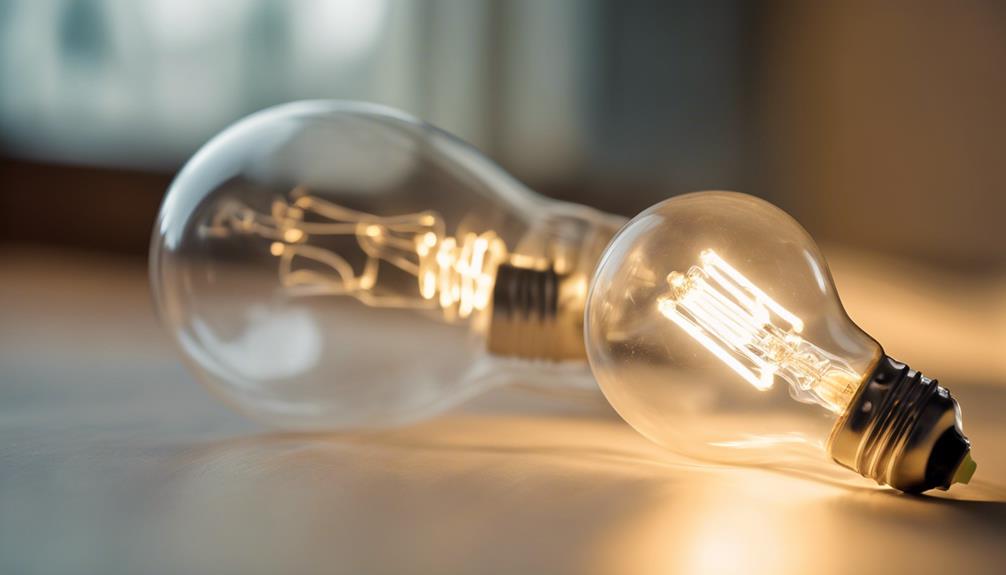
LED lighting is considerably more energy-efficient than incandescent lighting, consuming about 75% less energy. LED bulbs typically use only 10 watts, while incandescent bulbs require 60 watts.
The energy-saving benefits of LEDs make them a superior choice for reducing electricity consumption and promoting sustainability.
Efficiency Comparison: LED Vs. Incandescent
Comparing the energy consumption of LED lighting to incandescent lighting reveals a substantial difference in efficiency. Here are some key points to take into account:
- LED lighting uses at least 75% less energy than incandescent lighting.
- LEDs can save an average household about $225 per year in electricity costs.
- On average, LED bulbs consume around 10 watts compared to 60 watts for incandescent bulbs.
- By 2035, LED technology is expected to save up to 569 terawatt-hours of energy annually.
- LED bulbs last up to 25 times longer than traditional incandescent bulbs.
Energy-Saving Benefits of LEDS
With their markedly lower energy consumption, LED lighting offers substantial energy-saving benefits compared to incandescent lighting. Residential LEDs use at least 75% less energy than incandescent bulbs, leading to significant cost savings for consumers. Additionally, LED lights last up to 25 times longer, reducing the frequency of replacements and further contributing to energy efficiency.
Environmental Impact of LED Lighting
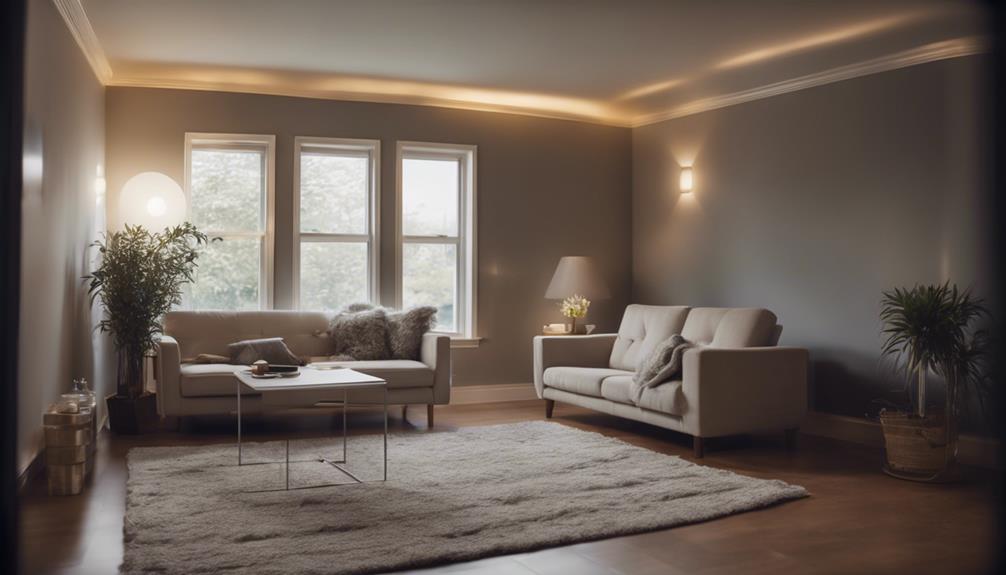
The environmental impact of utilizing LED lighting technology is significant in reducing energy consumption and minimizing waste. LED lighting plays an important role in promoting environmental sustainability through various means:
- LED lighting reduces carbon footprint by consuming up to 90% less energy than incandescent bulbs.
- The use of LED lights results in fewer bulbs ending up in landfills due to their long lifespan.
- ENERGY STAR labels help identify energy-efficient LED bulbs for environmentally conscious consumers.
- LED lights are highly directional, providing focused light and reducing light pollution.
- Choosing LED bulbs over traditional options decreases the need for frequent bulb shipments, contributing to environmental sustainability.
These aspects highlight how LED lighting not only conserves energy but also positively impacts the environment by reducing waste, minimizing carbon emissions, and promoting sustainable practices.
The adoption of LED technology aligns with global efforts towards a greener and more sustainable future.
Calculating LED Energy Savings
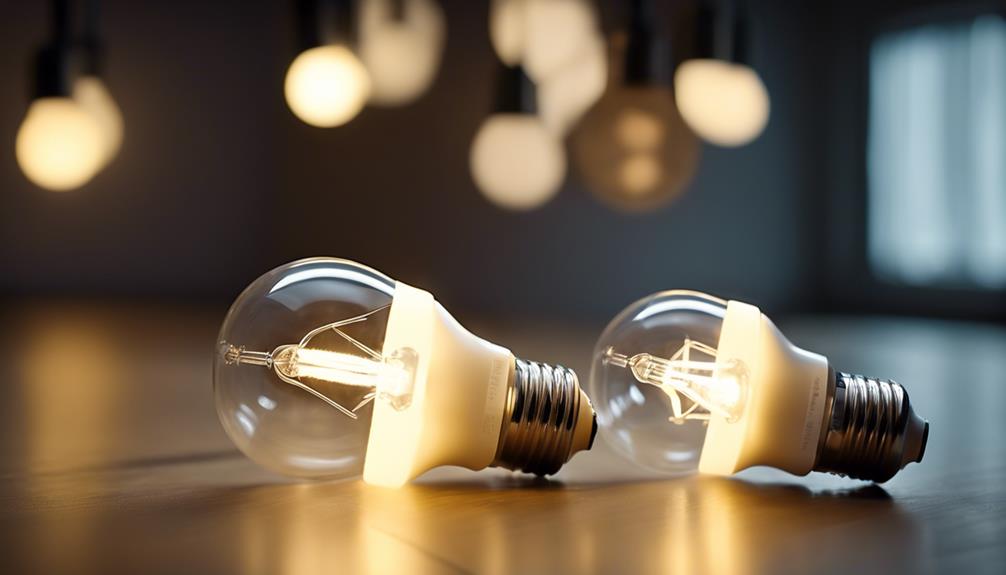
LED energy savings can be calculated through an energy efficiency comparison, cost savings analysis, and an environmental impact assessment.
These points help individuals understand the benefits of switching to LED lighting and the long-term financial advantages it offers.
Energy Efficiency Comparison
By comparing energy efficiency between different types of lighting, one can clearly see the significant savings potential associated with LED technology.
- LED lighting uses up to 90% less energy than incandescent bulbs.
- LED bulbs consume around 10 watts on average, while incandescent bulbs consume 60 watts.
- LED technology is projected to dominate all lighting installations by 2035.
- Energy savings from LED lighting could reach an impressive 569 terawatt-hours annually by 2035.
- Switching to LED lighting leads to substantial cost savings and reduced electricity consumption over time.
Cost Savings Analysis
Calculating potential energy savings with LED lighting can provide valuable insights into long-term cost efficiency and sustainability. LED lighting can save an average household about $225 per year compared to traditional incandescent lighting. Switching to LEDs can result in savings of around $4,000 over a 20-year LED bulb lifespan.
LED bulbs consume up to 90% less energy than incandescent bulbs, leading to significant cost savings. By estimating energy use in kilowatt hours (kWh), one can gauge the potential savings from switching to LEDs. Additionally, with LED bulbs lasting up to 25 times longer than traditional bulbs, the cost savings over their lifespan can be substantial.
Making the switch to LED lighting not only reduces energy consumption but also offers significant long-term cost benefits.
Environmental Impact Assessment
Switching to LED lighting greatly reduces energy consumption and offers long-term cost benefits, highlighting its positive environmental impact. LED technology plays an important role in enhancing energy efficiency and reducing the environmental footprint of lighting installations. Here are some key points to keep in mind:
- LED lighting saves at least 75% in energy compared to incandescent lighting.
- By 2035, LED technology could save up to 569 terawatt-hours of energy annually.
- LED bulbs last up to 25 times longer than traditional bulbs, reducing landfill waste.
- The energy saved by LED lighting is equivalent to the output of 92 1,000-megawatt power plants.
- LED lighting is highly effective, with the potential to dominate all lighting installations by 2035.
Benefits of LED Energy Conservation

LED lighting offers significant benefits for energy conservation, making it a cost-effective and environmentally friendly lighting choice. LED technology saves a minimum of 75% more energy than incandescent lighting, leading to substantial reductions in electricity consumption.
By 2035, it's projected that LED advancements could save up to 569 terawatt-hours of energy annually. This not only translates to significant cost savings for consumers, with the average household potentially saving around $225 per year, but also has a positive impact on the environment by reducing overall energy usage.
Additionally, LED bulbs are long-lasting, lasting up to 25 times longer than traditional bulbs. This longevity not only reduces waste but also minimizes the need for frequent replacements and shipping, further lessening the environmental impact.
Moreover, LED bulbs produce less heat compared to traditional lighting, decreasing the strain on air conditioning systems and contributing to overall energy efficiency.
LED Lighting Cost Savings

Efficient lighting technology like LEDs offers significant cost savings for households through reduced electricity consumption. When considering LED lighting cost savings, it becomes evident that households can benefit financially in various ways:
- LED lighting can save the average household about $225 per year in electricity costs.
- Switching to LED lighting can result in savings of around $4,000 over a 20-year LED bulb lifespan.
- LED bulbs use 75% less energy than incandescent bulbs, contributing to significant cost savings.
- LED technology is expected to dominate the lighting industry by 2035, leading to potential energy savings of 569 terawatt-hours annually.
- LED bulbs last up to 25 times longer than incandescent bulbs, reducing replacement and maintenance costs.
These facts highlight the tangible economic advantages of adopting LED lighting, demonstrating not only the immediate impact on electricity bills but also the long-term financial benefits of investing in energy-efficient lighting solutions.
LED Energy Consumption Comparison

LED lighting stands out for its impressive energy efficiency, consuming 75% less energy than incandescent bulbs.
By 2035, a significant shift towards LED technology is projected in the US, with potential annual energy savings reaching 569 TWh.
This comparison not only highlights the environmental benefits but also underscores the potential cost savings associated with adopting LED lighting solutions.
Energy Efficiency Benefits
Comparing the energy consumption of traditional incandescent bulbs to newer lighting technology reveals a significant difference in efficiency. LED lighting utilizes up to 90% less energy than incandescent bulbs, making it a more energy-efficient choice. Here are some key energy efficiency benefits of LED lighting:
- LED bulbs typically use about 10 watts, while incandescent bulbs use 60 watts, resulting in significant energy savings.
- An average home with incandescent bulbs consumes around 2,000 kWh of electricity per year; switching to LEDs can save approximately $4,000 over a 20-year LED lifespan.
- By 2035, LED technology is projected to dominate lighting installations in the US, potentially saving 569 terawatt-hours of energy annually.
- LED bulbs last up to 25 times longer than traditional incandescent bulbs, contributing to energy savings and reducing landfill waste.
Cost Savings Analysis
When comparing energy consumption, the cost savings analysis shows a significant difference between LED bulbs and incandescent bulbs. LED bulbs use 75% less energy than incandescent bulbs, resulting in substantial electricity cost savings.
A typical LED bulb consumes about 10 watts, while an incandescent bulb uses 60 watts, leading to significant energy savings. The long-lasting nature of LED bulbs, lasting up to 25 times longer than incandescent bulbs, reduces landfill waste and shipping needs.
Additionally, the efficient design of LED bulbs, producing less heat and offering highly directional light, contributes to energy savings and decreases the strain on air conditioning systems. As LED technology continues to advance, its dominance in lighting by 2035 is projected to save up to 569 terawatt-hours annually.
LED Lighting and Electricity Usage

With the increasing emphasis on energy efficiency, the impact of LED lighting on electricity usage has become an essential thing for homeowners and businesses alike. LED lighting offers noteworthy energy savings and can lead to a reduction in electricity consumption. Here are some key points to keep in mind:
- LED lighting uses up to 90% less energy than incandescent bulbs, resulting in substantial electricity savings.
- An average home using incandescent bulbs consumes about 2,000 kWh of electricity annually, a figure that can be markedly reduced by switching to LEDs.
- LED bulbs typically consume around 9-12 watts per hour, much lower than the 60 watts consumed by incandescent bulbs, contributing to decreased electricity usage.
- Switching to LEDs can save homeowners approximately $4,000 over a 20-year LED lifespan, making it a cost-effective choice for energy savings.
- LED technology is projected to dominate the lighting industry by 2035, potentially saving up to 569 terawatt-hours of energy annually.
LED Energy-Saving Technology
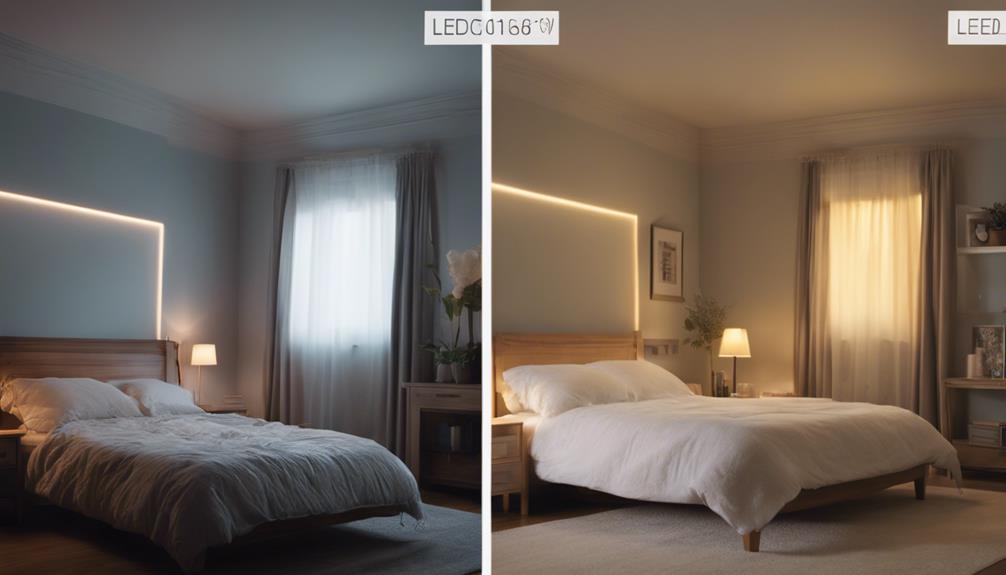
LED technology revolutionizes energy efficiency in lighting, surpassing traditional incandescent options by at least 75%. This advancement not only saves energy but also leads to significant household savings. The table below highlights key points showcasing the benefits of LED lighting:
| Features | LED Lighting | Incandescent Bulbs |
|---|---|---|
| Energy Efficiency | 75% more energy-efficient | Less energy-efficient |
| Lifespan | Lasts up to 25 times longer | Shorter lifespan |
| Cost Savings | Average household savings of about $225 per year | Higher electricity bills |
The energy-saving capabilities of LED lighting are further emphasized by the fact that by 2035, this technology is anticipated to save up to 569 terawatt-hours of energy annually. Additionally, the widespread adoption of LEDs in the US is projected to dominate the lighting industry by 2035, showcasing the shift towards more sustainable and cost-effective lighting solutions.
LED Lighting Energy Conservation

Energy conservation through the use of LED lighting greatly reduces energy consumption and promotes sustainability. LED lighting is a highly energy-efficient lighting option that offers significant benefits over traditional incandescent bulbs. Here are some key points worth noting:
- LED lighting can save at least 75% in energy compared to incandescent lighting.
- By 2035, LED technology is expected to save up to 569 terawatt-hours of energy annually.
- LED bulbs last up to 25 times longer than incandescent bulbs, contributing to energy savings.
- The majority of lighting installations in the US are anticipated to use LED technology by 2035.
- Residential LEDs can help the average household save about $225 per year in energy costs.
Frequently Asked Questions
How Much Energy Do You Save With LED Lights?
LED lights save a noteworthy amount of energy compared to traditional incandescent lighting. The energy savings with LED lights are substantial due to their efficiency.
How Much Does It Cost to Run a LED Light for 24 Hours?
Running a 10-watt LED light for 24 hours costs $0.024, based on the national average electricity rate of $0.10 per kWh. In comparison, a 60-watt incandescent bulb costs $0.144 for the same duration.
Making the switch to LED lighting can lead to significant savings on electricity bills over time. LED lights are a cost-effective and energy-efficient choice for continuous lighting needs, providing both economical and environmental benefits.
Are LED Lights 100% Efficient?
LED lights aren't 100% efficient. While they're highly efficient compared to traditional bulbs, some energy is still lost as heat.
The efficiency of LEDs varies based on factors like brightness, color temperature, and usage patterns. Despite this, LEDs remain a more energy-efficient lighting option due to their ability to convert a significant portion of electrical energy into light, resulting in overall energy savings.
Is It Cheaper to Leave LED Lights On?
Leaving LED lights on when not needed can still cost money due to electricity consumption. It's generally cheaper to turn off LED lights when they aren't needed to maximize energy savings.
Even though LED lights are energy-efficient, unnecessary usage can still waste electricity. Utilizing timers or motion sensors with LED lights can help automate turning them on and off for additional energy savings.
Conclusion
To sum up, LED lighting offers significant energy savings compared to traditional incandescent bulbs. As the old saying goes, 'A penny saved is a penny earned.'
By making the switch to LED lights, individuals and businesses can reduce their electricity consumption, lower their utility bills, and minimize their environmental impact.
The benefits of LED energy conservation are clear, making it a smart choice for those looking to save money and reduce their carbon footprint.
-

 Vetted7 months ago
Vetted7 months ago15 Best EMS Foot Massagers for Neuropathy to Soothe Your Feet
-

 Vetted6 months ago
Vetted6 months ago14 Best Personalized Father's Day Gifts for Your Husband – Show Him You Care
-

 Alfresco6 months ago
Alfresco6 months agoAlfresco Stacker Doors: Seamless Indoor-Outdoor Living!
-

 Tableware and Dining Accessories2 days ago
Tableware and Dining Accessories2 days agoWhat Is the Meaning of the Word Tableware
-

 Tableware and Dining Accessories2 days ago
Tableware and Dining Accessories2 days agoWhen Is Tableware on Sale at Hobby Lobby
-

 Tableware and Dining Accessories2 days ago
Tableware and Dining Accessories2 days agoWhich of the Following Is Not Classified as Tableware
-

 Craft and Textiles8 months ago
Craft and Textiles8 months ago15 Best Places to Buy Appliances for Your Home – Top Retailers Reviewed
-

 Vetted6 months ago
Vetted6 months agoBattle Born Batteries Review: Reliable Power Solution




























